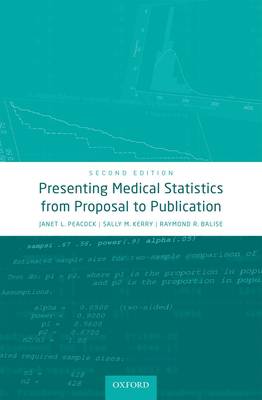
- Retrait gratuit dans votre magasin Club
- 7.000.000 titres dans notre catalogue
- Payer en toute sécurité
- Toujours un magasin près de chez vous
- Retrait gratuit dans votre magasin Club
- 7.000.000 titres dans notre catalogue
- Payer en toute sécurité
- Toujours un magasin près de chez vous
Presenting Medical Statistics from Proposal to Publication
Janet L Peacock, Sally M Kerry, Raymond R Balise
Livre broché | Anglais
67,45 €
+ 134 points
Description
As many medical and healthcare researchers have a love-hate relationship with statistics, the second edition of this practical reference book may make all the difference. Using practical examples, mainly from the authors' own research, the book explains how to make sense of statistics, turn statistical computer output into coherent information, and help decide which pieces of information to report and how to present them. The book takes you through all the stages of the research process, from the initial research proposal, through ethical approval and data analysis, to reporting on and publishing the findings. Helpful tips and information boxes, offer clear guidance throughout, including easily followed instructions on how to:
-develop a quantitative research proposal for ethical/institutional approval or research funding
-write up the statistical aspects of a paper for publication
-choose and perform simple and more advanced statistical analyses
-describe the statistical methods and present the results of an analysis. This new edition covers a wider range of statistical programs - SAS, STATA, R, and SPSS, and shows the commands needed to obtain the analyses and how to present it, whichever program you are using. Each specific example is annotated to indicate other scenarios that can be analysed using the same methods, allowing you to easily transpose the knowledge gained from the book to your own research. The principles of good presentation are also covered in detail, from translating relevant results into suitable extracts, through to randomised controlled trials, and how to present a meta-analysis. An added ingredient is the inclusion of code and datasets for all analyses shown in the book on our website (http: //medical-statistics.info). Written by three experienced biostatisticians based in the UK and US, this is a step-by-step guide that will be invaluable to researchers and postgraduate students in medicine, those working in the professions allied to medicine, and statisticians in consultancy roles.
-develop a quantitative research proposal for ethical/institutional approval or research funding
-write up the statistical aspects of a paper for publication
-choose and perform simple and more advanced statistical analyses
-describe the statistical methods and present the results of an analysis. This new edition covers a wider range of statistical programs - SAS, STATA, R, and SPSS, and shows the commands needed to obtain the analyses and how to present it, whichever program you are using. Each specific example is annotated to indicate other scenarios that can be analysed using the same methods, allowing you to easily transpose the knowledge gained from the book to your own research. The principles of good presentation are also covered in detail, from translating relevant results into suitable extracts, through to randomised controlled trials, and how to present a meta-analysis. An added ingredient is the inclusion of code and datasets for all analyses shown in the book on our website (http: //medical-statistics.info). Written by three experienced biostatisticians based in the UK and US, this is a step-by-step guide that will be invaluable to researchers and postgraduate students in medicine, those working in the professions allied to medicine, and statisticians in consultancy roles.
Spécifications
Parties prenantes
- Auteur(s) :
- Editeur:
Contenu
- Nombre de pages :
- 256
- Langue:
- Anglais
Caractéristiques
- EAN:
- 9780198779100
- Date de parution :
- 20-09-17
- Format:
- Livre broché
- Format numérique:
- Trade paperback (VS)
- Dimensions :
- 155 mm x 231 mm
- Poids :
- 430 g







